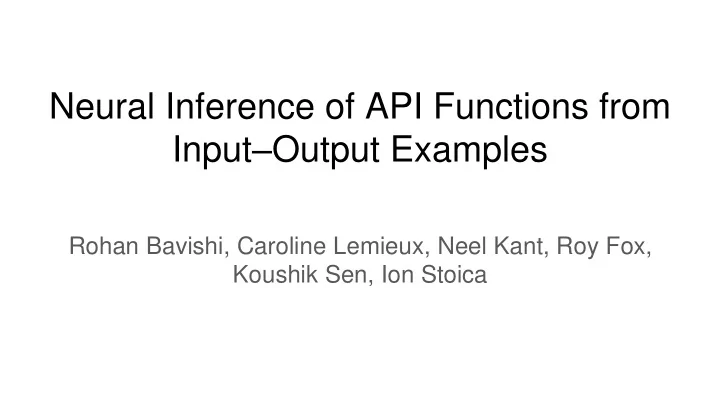

Neural Inference of API Functions from Input – Output Examples Rohan Bavishi, Caroline Lemieux, Neel Kant, Roy Fox, Koushik Sen, Ion Stoica
Introduction ● Discovering what APIs to use can be time difficult and time-consuming ● Speed of creation of new APIs outpaces the completeness, clarity, and even correctness of the documentation ● Program synthesis is the process of automatically generating a program conforming to a higher-level specification ● Goal is the automating the process of finding the correct API given a set of input-output values
Challenges ● For a language with n functions , taking an average of m argument values, the number of sequential programs of length k grows as (nm) k ● Existing approaches work on small subsets of problems or Domain Specific Languages ● Identify the actual function and its arguments, which may have interactions ● Exhaustive search is feasible for determining arguments but not functions ● Use a hybrid approach with exhaustive search for arguments and a neural inference mechanism to predict the functions
Methodology Map a given I/O example to a pandas function which performs the transformation specified by the example Steps: 1. Preprocessing I/O examples into a graph 2. Feeding these examples into a trainable neural network which learns a high- dimensional representation for each node of the graph, 3. Pooling to output of the neural network and applying softmax to select a pandas function. 4. Use exhaustive search to find the correct arguments
Graph Abstraction The operation used in an I/O example is often captured by the relationships amongst the elements, rather than the concrete data itself
Nodes Edges ● ● Every data cell in the input and output Edges to represent the relationships DataFrame is represented as a single between nodes in input and output ● node Equality edges are between any nodes ● Multiple levels of column names or row with the same value ● indices appear as additional nodes Adjacency edges represent the basic ● Node is labeled with a type tuple (data structural characteristics of the type, is input) DataFrames ● Indexing edges are between a column name (resp. row index) and all the data nodes that belong to that column
Gated Graph Neural Networks Graph Neural Networks map graphs to outputs via two steps: 1. Propagation step that computes node representations for each node 2. Compute output model that maps from node representations and corresponding labels to an output Gated Graph Neural Networks : GNN with recurrent unit that stores node state and uses backpropagation through time in order to compute gradient
Network ● Edge e is a 3-tuple (v s , v t , t e ) where v s and v t are the source and target nodes and t e is the type of the edge. ● Every node v has a corresponding state vector ● Information is propagated using message passing across k rounds ● For each node, the incoming messages are aggregated ● The new node state vector for the next round is computed using recurrent unit ● Element-wise sum-pool the node state vectors into a graph state vector h. ● Use a multi-layer perceptron with one hidden layer, and apply softmax to produce a probability distribution over the target classes
Accuracy Results Accuracy is computed using (1) synthesized validation set and (2) I/O examples taken from real-world sources
Thoughts Pros: ● Encoding I/O pairs as a graph ● Flexible compared to existing approaches Doubts: ● Limited to single function programs ● Scalability and performance in real world data ● Does not consider parameter selection
Recommend
More recommend